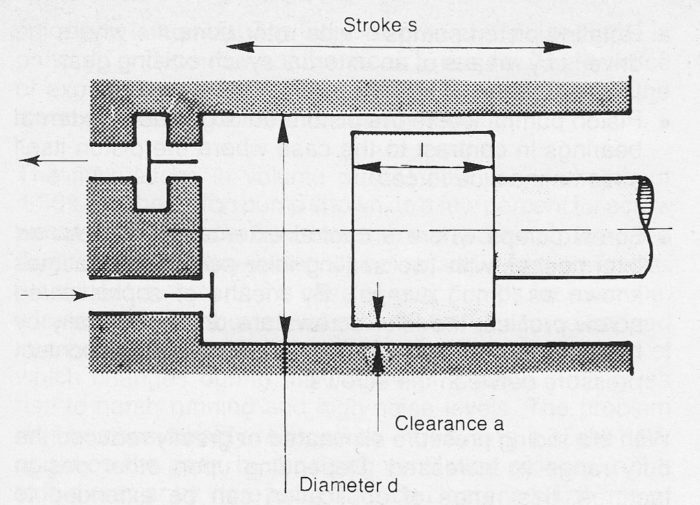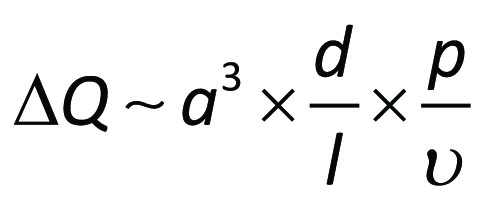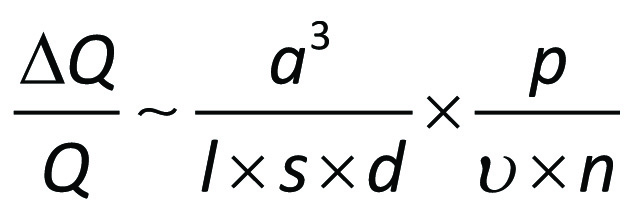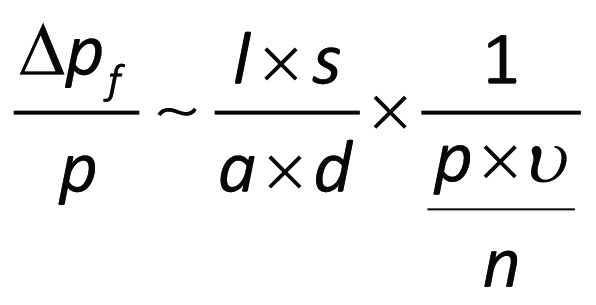3.3.1 Loss and efficiency in positive displacement pump
Loss and efficiency in positive displacement pump
Loss and efficiency in positive displacement pump is determined by the appearance of losses as, internal leakage, internal friction, flow losses in inlet and outlet ports and mechanical losses. The overall loss is also dependent upon the principle of construction and viscosity of the liquid.
A comparative theoretical observation can be made for displacement pumps by expressing the various construction principles in terms of an equivalent pump. The values which determine leakage, friction and other losses are converted to those of an equivalent pump having the same performance and losses. The equivalent pump figure 3.31a is then studied in regard to the size of the losses. To clarify this idea a piston pump has been chosen as a working example.

Figure 3.31a Important dimensions of an equivalent reciprocating displacement pump.
By using the terms:
ʋ for kinematic viscosity
n for number of strokes (speed)
Q for volume flow
p for pressure increase
the various losses, assuming laminar flow, of an equivalent pump can be determined as follows:
- Internal leakage

- Relative leakage

- Sliding friction loss

- Relative sliding friction loss

- Flow losses through ports

- Mechanical losses
It can be observed that the various losses are dependent upon the parameter p/vn as shown in figure 3.99. Leakage losses are proportional to pressure increases and inversely proportional to viscosity and speed. Leakage losses are also proportional to the cube (third power) of ‘a’ and sliding friction losses are inversely proportional to ‘a’. This relationship does not however take thermal effects into account, i.e. local viscosity reductions due to rise in liquid temperatures.

Figure 3.31b losses in a displacement pump are dependent on the parameter p/vn. Leakage losses, upper illustration, increase with this parameter, whilst sliding friction losses, lower illustration, decrease.
The overall losses figure 3.31c are at a minimum when the relative leakage losses are approximately equal to the sliding friction losses. The optimum value for p/vn is determined by the piston dimensions etc. of the equivalent pump. The dimensions of the “equivalent” pump piston varies greatly according to the type of displacement pump. The practical conclusion being that each type of displacement machine has its own specific operating range

Figure 3.31c The total losses are at a minimum when the component losses are equal.
By studying the equivalent displacement pump it can be directly concluded that:
- A reciprocating pump for high pressure should be constructed with a long small diameter piston so-called plunger-pump. Piston friction on the other hand becomes too high if used for high viscosity.
- A reciprocating pump for high viscosity should have a short piston i.e. the opposite to a plunger-pump. In extreme cases a diaphragm pump should be used.
- Similarly, a gear pump should have many teeth for high pressure and low viscosity and few teeth for low pressure and high viscosity.
